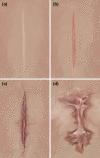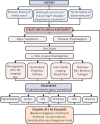A comprehensive evidence-based review on the role of topicals and dressings in the management of skin scarring
- PMID: 26044054
- PMCID: PMC4506744
- DOI: 10.1007/s00403-015-1572-0
A comprehensive evidence-based review on the role of topicals and dressings in the management of skin scarring
Abstract
Wound healing after dermal injury is an imperfect process, inevitably leading to scar formation as the skin re-establishes its integrity. The resulting scars have different characteristics to normal skin, ranging from fine-line asymptomatic scars to problematic scarring including hypertrophic and keloid scars. Scars appear as a different colour to the surrounding skin and can be flat, stretched, depressed or raised, manifesting a range of symptoms including inflammation, erythema, dryness and pruritus, which can result in significant psychosocial impact on patients and their quality of life. In this paper, a comprehensive literature review coupled with an analysis of levels of evidence (LOE) for each published treatment type was conducted. Topical treatments identified include imiquimod, mitomycin C and plant extracts such as onion extract, green tea, Aloe vera, vitamin E and D, applied to healing wounds, mature scar tissue or fibrotic scars following revision surgery, or in combination with other more established treatments such as steroid injections and silicone. In total, 39 articles were included, involving 1703 patients. There was limited clinical evidence to support their efficacy; the majority of articles (n = 23) were ranked as category 4 LOE, being of limited quality with individual flaws, including low patient numbers, poor randomisation, blinding, and short follow-up periods. As trials were performed in different settings, they were difficult to compare. In conclusion, there is an unmet clinical need for effective solutions to skin scarring, more robust long-term randomised trials and a consensus on a standardised treatment regime to address all aspects of scarring.
Figures



References
-
- Ahn ST, Monafo WW, Mustoe TA. Topical silicone gel: a new treatment for hypertrophic scars. Surgery. 1989;106(4):781–786. - PubMed
-
- Al-Attar A, Mess S, Thomassen JM, Kauffman CL, Davison SP. Keloid pathogenesis and treatment. Plast Reconstr Surg. 2006;117(1):286–300. - PubMed
-
- Asilian A, Darougheh A, Shariati F. New combination of triamcinolone, 5-Fluorouracil, and pulsed-dye laser for treatment of keloid and hypertrophic scars. Dermatol Surg. 2006;32(7):907–915. - PubMed
-
- Atiyeh BS, Amm CA, El Musa KA. Improved scar quality following primary and secondary healing of cutaneous wounds. Aesthet Plast Surg. 2003;27(5):411–417. - PubMed
-
- Atiyeh BS, Ioannovich J, Al-Amm CA, El-Musa KA, Dham R. Improving scar quality: a prospective clinical study. Aesthet Plast Surg. 2002;26(6):470–476. - PubMed
Related articles recently published in Archives of Dermatological Research (selected by the journal’s editorial staff):
-
- Zurada JM, Kriegel D, Davis IC. Topical treatments for hypertrophic scars. J Am Acad Dermatol. 2006;55(6):1024–1031. - PubMed
-
- Bahramsoltani R, Farzaei MH, Rahimi R. Medicinal plants and their natural components as future drugs for the treatment of burn wounds: an integrative review. Arch Dermatol Res. 2014;306:601–617. - PubMed
-
- Kim SH, Jung SH, Chung H, Jo DI, Kim CK, Park SH, Won KJ, Jeon HS, Kim B. Annexin A2 participates in human skin keloid formation by inhibiting fibroblast proliferation. Arch Dermatol Res. 2014;306:347–357. - PubMed
Publication types
MeSH terms
Substances
LinkOut - more resources
Full Text Sources
Other Literature Sources
Medical
Research Materials

